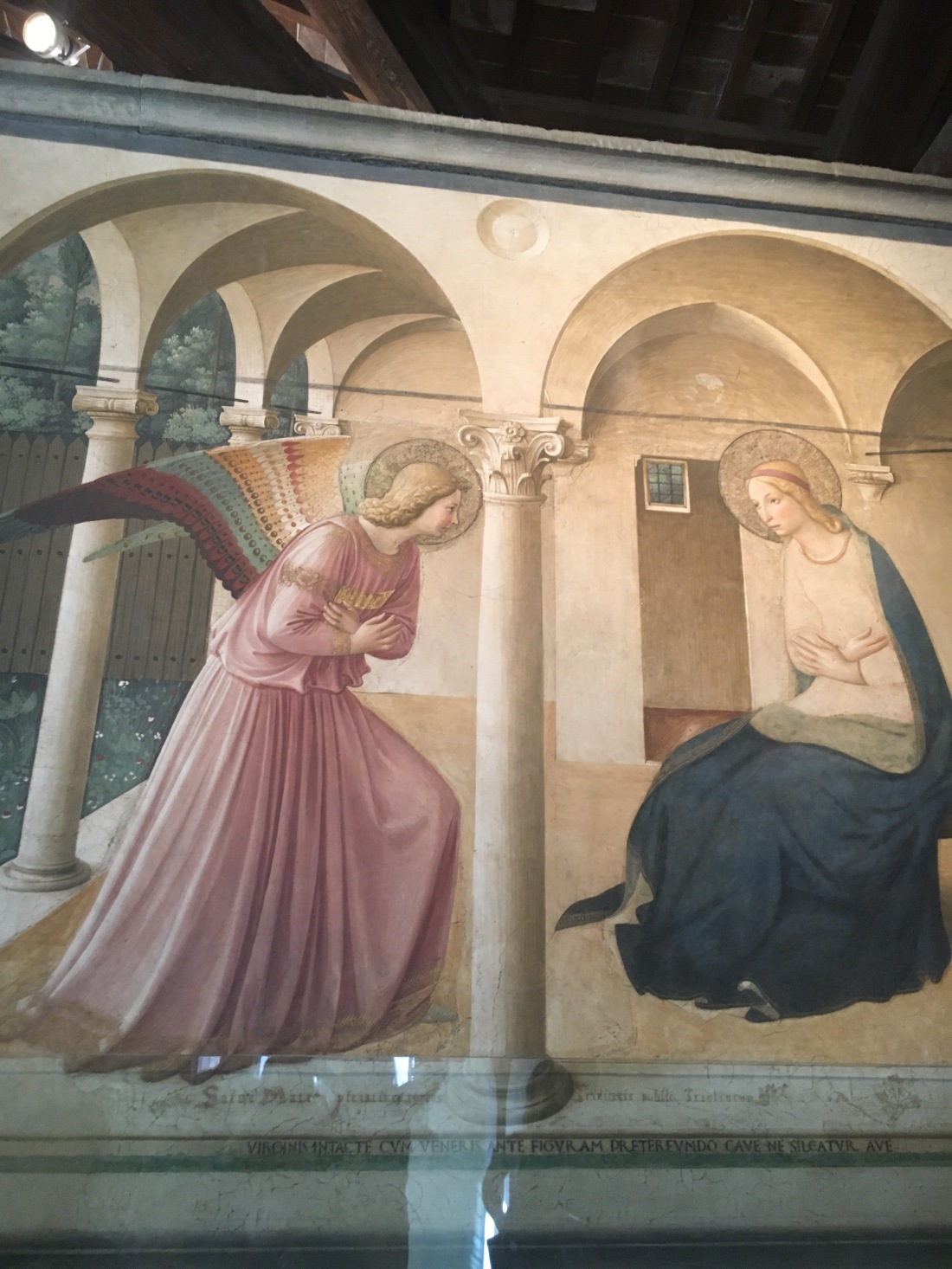In Florence I was able to have the wonderful opportunity to go to the Museum of San Marco and look at many of the frescos by Fra Angelico. The museum is full of frescos by him that were commissioned by Cosimo from the Medici family (Vasari, 2008), however the one that stuck out to me the most because it was so different was The Annunciation.

The first impact of the painting is that there is an aura of importance. It is the depiction where the angel Gabriel visits Mary and you can tell that it is Mary by her signature blue robe. The viewers eye starts off at the angel, due to the colors that Fra Angelico used on the wings. They are full of color, which contrasts from the beige natural background. They range in color from beige to green to red and then to a very dark green, almost black color. The viewer’s eyes then move to the Virgin Mary because she is the only other figure within the painting. Fra Angelico is trying to show that Gabriel is delivering Mary a message, so the viewers eyes should start on him initially and then move to her. The message being delivered is that Mary is pregnant with Jesus, and a way in which the viewer would be able to realize this is that both Mary and Gabriel have their arms wrapped around their stomachs. They are the focal point of the painting because they are the only two figures in the painting. After looking at them, the eyes are allowed to wander to look at the architecture and the foliage. Another interesting part of the painting is the lines used. There is both a real directional line and an eye line, however is less about a color line. Fra Angelico places a black line on top to show the method in which he was able to create perspective and a vanishing point. This also shows the mathematics he used and learned from Brunelleschi. The two figures are also separated by one line, the column in between the two figures. The eye line is between the Angel and Mary because they are looking straight at one another, this creates a a sense of importance because they are locking eyes and not paying attention to anything else. The only time in which I would see a color line is with Gabriel’s wings. This is because they begin light like the wall and then move your eye downwards towards the background and grass by becoming gradually darker until they reach the background. Other than the foliage background there is the beige background which takes up most of the painting, which shows the separation of the angel and Mary through contrasting colors. There are both neutral colors and primary/secondary colors. The background is all neutral beige, while the angel Gabriel is in pink and the Virgin Mary is in blue. The bright blue and pink contrasts with the beige background. The landscape is in green and the Angel’s wings are multicolored, going from light to dark. There do not tend to be many shades unless it is found in the clothing to create demension, which is called cairoscuro and is what Fra Angelico is known for. The impact of the colors is not harsh, and have almost an elegant quality to them, which Presents the feeling that the artist would like the viewer to have. He shows that something important is occurring and it is a good thing. The light colors symbolize that there is an occurrence to be happy about. There is also no harshness with the shapes being used. They tend to be all natural and organic, such as clothes, people, and trees. The only part of the painting that is harsh is the black line going through the top, and Fra Angelico used that to create perspective and natural shapes and vanishing points using the arches and architecture in a natural way.
The artist tried to make the viewer have a spiritual connection with the work, due to his history and connection to the Catholic Church. He was a friar and was therefore extremely spiritual and enjoyed painting stories from his religion and wanted this to influence the viewer. The painting stimulates me visually, however not emotionally because I don’t identify very much with the Catholic religion and these stories do not stimulate my spirituality. On the other hand, I think that the three dimensionality of the painting and use of different colors is very visually stimulating, especially the use of cairoscuro on the clothing. The artist is trying to show the viewer that this is an important scene and that it has a good connotation. It is a good moment and Fra Angelico is skilled at showing this by making sure that the Virgin and Gabriel both have sweet looks on their faces.
Vasari, Giorgio, Julia Conaway. Bondanella, and Peter E. Bondanella. Lives of the Artists. Oxford: Oxford UP, 2008. Print.